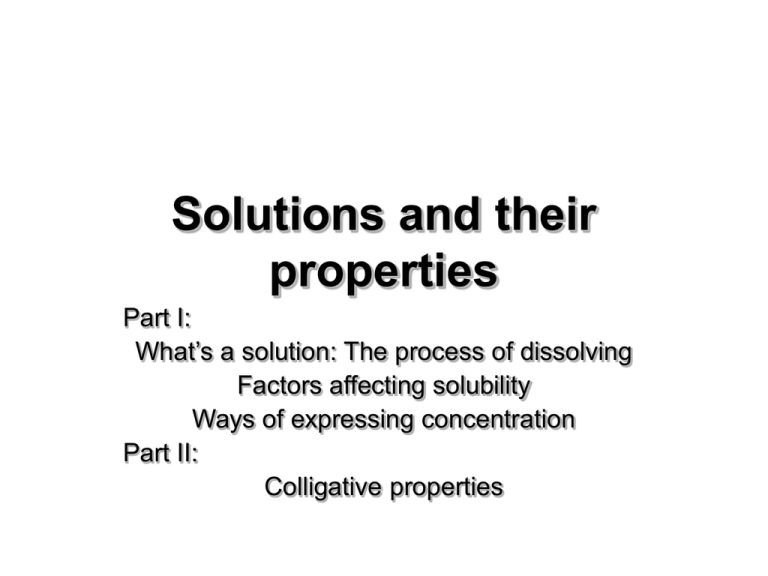Solutions and their properties (download)
advertisement

Solutions and their properties Part I: What’s a solution: The process of dissolving Factors affecting solubility Ways of expressing concentration Part II: Colligative properties Learning objectives • • • • • • Describe a solution Describe factors influencing solubility Predict solubility based on molecular properties Describe effect of temperature on solubility Predict solubility of gases using Henry’s law Perform concentration calculations using molarity, molality, mole fraction and percent by mass and volume Mixtures are a fact of life • We learn about matter by studying pure substances • In nature, most things are mixtures – nothing is “pure”: – Air – Water – Soil – Living systems Solution or colloid? • Both contain a solid dispersed in a liquid • In a solution, the particle size is on the molecular scale (< 1 nm) • In a colloid, the particles are larger (2 – 500 nm) • Colloids scatter light – milk, fog Why do solutions form? • Things tend to get mixed up (entropy) • Without any interactions between molecules, gases always mix • Intermolecular forces complicate matters – May improve mixing if forces in mixture are stronger – May oppose mixing if forces in pure substances are stroner • Three intermolecular forces: – Solvent – solvent – Solute – solute – Solvent – solute • Like dissolves like: – Polar solvents dissolve polar solutes – Nonpolar solvents dissolve nonpolar solutes Review of intermolecular forces Name of force Origin Strength Ion-dipole Between ions and molecules Quite strong (10 – 50 kJ/mol) Dipole-dipole Between permanent dipoles Weak (3 – 4 kJ/mol) Hydrogen bonds Polar bonds with H and (O,N) Quite strong (10 – 40 kJ/mol) London dispersion forces Fluctuating dipoles in non-polar bonds Weak (1 – 10 kJ/mol) Ion - dipole • Characteristic of interactions in solutions of ionic compounds in polar solvents – Negative ion with the positive dipole end – Positive ion with the negative dipole end Dipole - dipole • Important attractive force in polar substances • Strength of the order of 3 – 4 kJ/mol (compared with 200 – 400 kJ/mol for covalent bonds) Dipole force manifested in boiling points: • Nonpolar substances have much lower boiling points – Acetone (polar) 56ºC butane (nonpolar) -0.5ºC • Boiling point increases with dipole strength London calling • Even molecules with no net dipole moment attract each other. • Electrons are not static but mobile: – Fluctuation creates dipole in one molecule which induces dipole in another molecule • Effect increases with atomic number – as atom becomes more polarizable – Boiling increases with molar mass • For small molecules, dispersion forces are weaker than other intermolecular forces. For large molecules this is not true. Large Solute – solvent interactions • The stronger the interactions between solute and solvent, the greater the solubility – Dispersion forces, dipolar interactions and liquids – Ion-dipole interactions and ionic compounds in water Dissolving an ionic compound • Attractive forces between solute and solvent compensate attractive forces between solute – solute and solvent solvent Solution on the atomic scale • The ions held tightly in the crystal lattice become solvated by water molecules • Ion-ion interactions are replaced by iondipole interactions in the solution Profits and losses • Energy costs – Solvent – solvent interactions – Solute – solute interactions (lattice energy) • High lattice energy → low solubility • Energy gain – Solvent – solute interactions • Small, more highly charged ions have stronger interactions Solutions, disorder and entropy • Substances dissolve with either gain or loss of enthalpy • Dissolving usually results in an increase in entropy • Exothermic processes tend to occur spontaneously • Processes that result in increased entropy tend to occur spontaneously Strong interactions complicate predictions about solubility • Weak interactions: – Gases mix completely over all compositions • Moderate interactions: – Liquids exhibit limits on range of miscibility • Strong interactions: – Solubility of ionic compounds varies – Some ionic compounds are completely insoluble Super-saturate me • Saturated solution is in equilibrium with undissolved solute and cannot contain any more solute Supersaturation: a state of the solution where it contains more solute than allowed by saturation. Non-equilibrium condition • Crystallization and rainfall depend on supersaturation Temperature and solubility • Solubility is amount of solute present in solution at saturation point • Solubility varies widely from compound to compound • Solubility varies with T – Most substances increase with T (KNO3) although the dependence can vary – Some are unaffected by T (NaCl) – A few decrease with T (Na2SO4) • Results can be explained by sign of ΔH solution and Le Chatelier’s principle (later) Gases always decrease solubility with temperature • Solubility of gases always decreases as temperature increases Solubility and pressure • For solutions of solids in liquids and liquids in liquids, pressure has almost no effect. • For gases in liquids: • Henry’s Law operates Solubility = k P • Solubility of gas depends on partial pressure above solution • k is function of gas for given solvent Henry’s law and equilibrium • Amount of gas in solution is in equilibrium with gas above solution • When P is increased, density of molecules above solution increases • More molecules enter solution to restore equilibrium Concentration: ways of expressing it • • • • Molarity Mole fraction Mass percent/volume percent Molality Molarity (M) Molarity (M) = • • • • Moles solute (mol) Vol solution (L) Stoichiometry calculations are easy Amounts of solution required are volumetric Concentration varies with T Amount of solvent requires knowledge of density Mole Fraction (X) Mole fraction (X) = Moles solute (mol) Moles solution (mol) • Dimensionless • Independent of temperature • Used for gas mixtures and solid solutions Mass percent (mass %) Mass percent = Mass solute (g) x 100% Mass solution (g) • For very dilute solutions: Parts per million (ppm) = Mass solute (g) Mass solution (g) x 10 • Independent of temperature • Need to work with masses rather than volumes 6 Molality (m) Molality (m) = • • • • Moles solute (mol) Mass solvent (kg) Used in calculations of colligative properties Independent of temperature Need to know mass of solution Need to know density to convert to molarity







